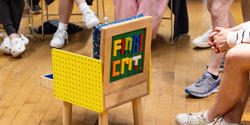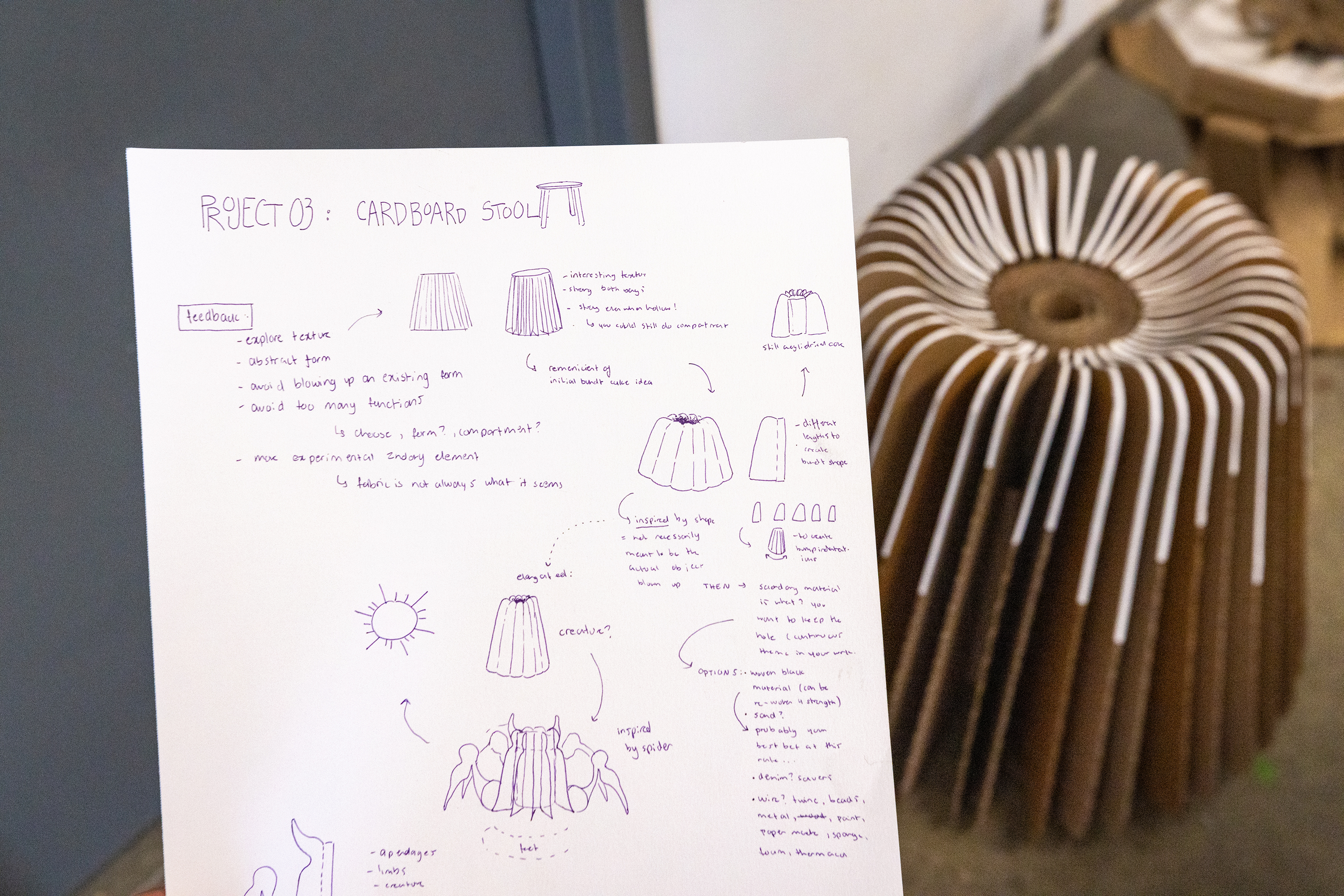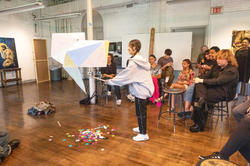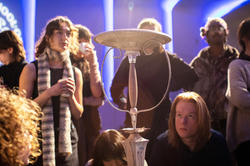Students in every department shared their work with classmates, professors and visiting experts in their fields.
RISD Students Present Final Projects to Peers, Professors and Visiting Critics

Critique is an integral part of RISD’s pedagogy. The ability to give and receive constructive criticism and then integrate that feedback into the next iteration of a project serves artists, designers and scholars long after they’ve graduated.
As the spring rain pours down outside RISD’s What Cheer Garage, students in an Experimental and Foundation Studies Spatial Dynamics studio led by Professor Lothar Windels BID 96 take turns presenting stools they’ve created out of cardboard, discussing the challenges they experienced and testing out one another’s designs. “I’m impressed by the construction of this piece, but I think you’d benefit from exposing yourself to chaos,” Windels tells one young designer. “That might help you break out of the tightness I see here.”
Nearby in the Design Center, the Photography department has gathered to critique work by sophomores, including a series of cemetery photos by transfer student Seungwon Baek 26 PH. The images were inspired by the loss of Baek’s older sister, who died before he was born but had a profound impact on his childhood. Faculty member Thad Russell MFA 06 PH, who is leading the crit, responds to an observation that photos of gravestones can be seen as cliché. “I’ve seen a lot of pictures of cemeteries over the years and have made a lot myself,” he notes. “But what changed my perception of these images is the artist statement. These pictures are an exercise in mourning and newly discovered grief.”


Sophomore Textiles students in a weaving course taught by Assistant Professor Amalia Galdona Broche are showing multiple projects they’ve completed over the course of the year almost in the form of installations. Ethan Lam 26 TX, whose work is inspired by drawing, has created a cozy space reminiscent of his childhood bedroom, where he did most of his making in years past. “The way you framed these pieces is so effective,” Professor Anais Missakian 84 TX notes. “Every decision you made serves the intimacy you’re trying to create here. And I like the fact that you’re not too precious about the work—not afraid to experiment.”
Upstairs, fellow sophomore Fiona Fan 26 TX shows her growing body of work, including an origami-inspired backpack that opens up into a beautiful scarf. Associate Professor Mary Anne Friel is impressed by her ability to play with a variety of themes, noting, “You have a huge range of skills and ideas to bring into your practice.”


Studios are buzzing in the Architecture & Design division as well, with Industrial Design students in a studio led by faculty member Asher Rodriquez-Dunn 08 ID sharing their final projects: playful upholstered chairs for children. “I like the way you’ve referenced LEGOs in this chair, but I think you could go even further in that direction,” Rodriquez-Dunn tells junior Skyler Lam 25 ID. “By borrowing design elements from elsewhere in the piece you can create a more cohesive design.”
Also in the Industrial Design department, students in an advanced studio called Design for Extreme Environments are showing their collaborative final project—a portable, self-contained field hospital featuring NASA space technology that can be dropped into disaster zones. They present the work to faculty member Michael Lye 96 ID and visiting designers—including RISD alums Skye Ray 16 ID, now a NASA designer, and Karan Mudgal 13 ID—and point out key features, like an operating room, trauma bay and pharmacy.


Another impressive collaborative project comes from Interior Architecture grad students working together to transform an empty 1969 high-rise building in Boston (one of many) into a vibrant cultural cornerstone powered in part by integrated wind turbines. “The turbines we designed would cover 50% of the building’s energy needs via piezoelectric panels with solar platelets, and the energy could be stored for days when it’s not windy,” the students tell the panel of visiting critics. Their proposal also features a mix of affordable and market-rate apartments, a rooftop pool enclosed in glass and a gym and other amenities for residents. Co-led by Professor Liliane Wong and Assistant Professor Michael Grugl, the yearlong “super-studio” embodies the essence of the department’s post-professional MA in Adaptive Reuse degree.
Finally, undergraduate Architecture students in an Architectural Design studio led by Professor Christopher Bardt BArch 83 show original designs for a performing arts center integrated into the sloped surrounding landscape. Nhat Nguyen BArch 27 says he “explored the relationship between the roof and the site’s steep topography through sketching and used paper strips to design the shape of the roof structure and organize the space below.” Professor Gabriel Feld describes the work as “extraordinary” and an excellent example of the difference between “functional design and fluid architecture.”
Simone Solondz / photos by Jo Sittenfeld MFA 08 PH
June 10, 2024


